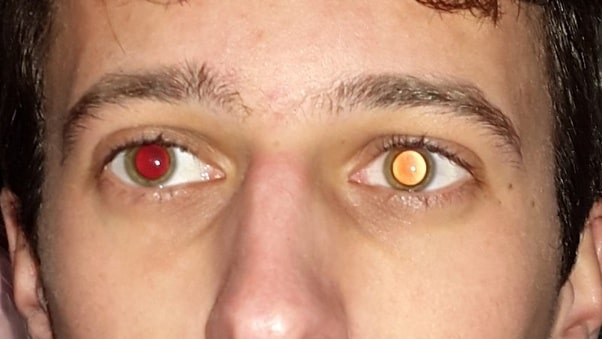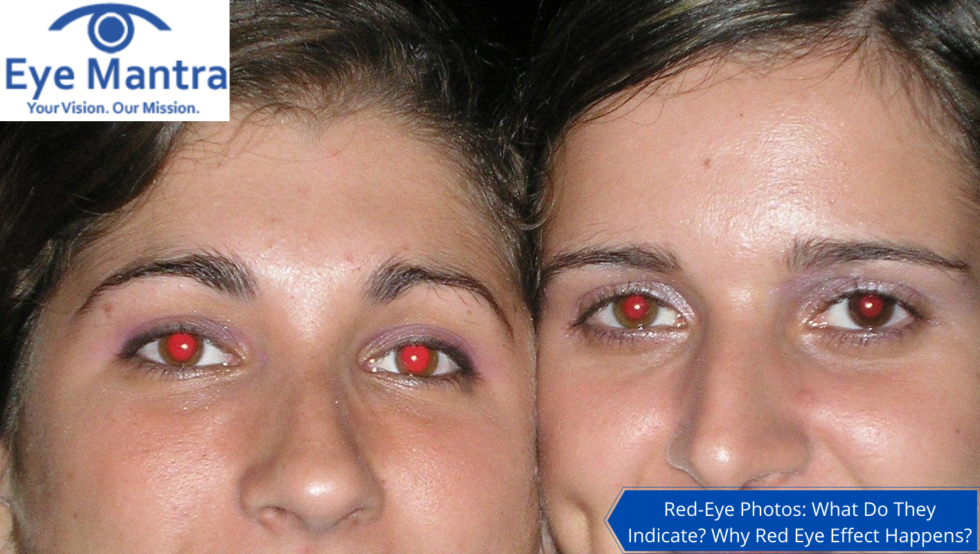Contents
What Is The Red-Eye Effect In Photos?
You may have noticed some of the pictures have red eyes. The Red-eye effect in photos is the appearance of red pupils in coloured photographs. Even though it could signal a serious eye problem like cataract or retinal detachment but it is very rare. Most of the time it is just a reflection of a flashlight from the camera.
Abnormal Red eyes in photos can help detect eye problems and could provide potentially sight saving information about the eyes. Red eye effect is captured in dark or dim light. It occurs when the person is looking directly into camera and flash is on when background light is dim.
What Causes Red Eye Photos?

The red-eye effect from photos is very common and mild. This effect occurs when the camera flash gets reflected from the retina.
When light enters eyes causing pupil to widen to allow light to reach the retina which is the inner layer of eye. Retina receives the light signals and sends them brain which forms the image.
In case of photographs, the flash light is not absorbed completely by retina and is reflected back creating red-eye effect. It illuminates the blood supply in retina producing the red colour you see in the pictures.
Very often there is ‘Abnormal red eye reflex’ which is a white, yellow or black reflection is seen in some photographs. It could be in one eye or both the eyes. This could be a sign of the presence of an eye condition. If you notice any abnormal signs consult an optometrist.
Possible Eye Conditions Associated With Abnormal Red Eye
occasionally, abnormal red reflexes can signal some dangerous eye conditions such as-
Strabismus

Strabismus is an eye condition in which both the eyes do not work in sync with each other. They can’t look at one place together. So, if one eye does not appear red could be a reason that it was not looking at the camera like other one.
Cataract or Retinoblastoma

If your pupil is covered with white reflex, it could be a warning sign of cataract, retinal detachment or even retinoblastoma which is a rare and serious childhood cancer of the eye. However, it is curable most of the time.
Coat’s Disease

This is a disease which causes blood vessels inside the retina of eye become twisted and leaky. It causes block in the retina leading to vision loss or even retinal detachment. The yellow reflex can be caused due to this disease.
Preventions of Red-Eye Effect In Photos
- Avert your eyes from the camera lens: If you don’t look directly at the flash, it reduces the chances of red-eye in photos. Not looking directly at the camera, will prevent the eyes to catch the flash light directly. It will decrease the chance of getting redd eye effect.
- Stay in a bright room: If the environment is dark, then the pupils get more dilated which will increase the chances of getting red-eye photos. If the room is bright, it eliminates the chances of red eyes.
- Use the anti-red eye function: New versions of cameras have an anti-red eye function to eliminate the red-eye effect and help capture frame-worthy photographs. In this feature the camera emits a light before it takes a picture as a result, the pupils of the subject constrict reducing the likelihood of red-eye photos.
- Move the flash away from the camera: If you have a camera with an external flash then you can move the flash away from the camera which minimizes the red-eye in photos. If the flash is away from the camera lens it prevents the light from reflecting from the pupil to the lens.
- Fix it later: The red-eye photos can be fixed by new editing systems in smartphones and other apps that can be downloaded. It has a feature of red-eye remover making your eye picture perfect.
Is There A Problem With Just One Red Eye In The Pictures?
Most of the time, there is one red-eye in photos because while taking a picture the subject was staring directly at the lens with one eye while the other eye was staring at a slightly different angle resulting in one red-eye in the picture.
Having one eye red in a photo could mean that person’s one eye was staring into camera and another was not. Whereas it could also mean an eye condition like strabismus which is misalignment of the eyes.
Sometimes redness in one eye can indicate an eye disease such as a tumor or cataract treatment. If you have one red eye in every photo you should visit a doctor for an eye exam.
Common Questions Asked About Red Eye Photos
- Why do only a few people get red-eye in group pictures?
This is because some people do not look directly at the camera lens, so the chances of the red-eye effect get eliminated.
- My child has red-eye in photos, does it indicate something bad?
Red-eye for children in photos is a good sign of growth. It shows that the child’s retina is unobstructed and that it is healthy. A child has more red-eyes in photos than adults because their eyes dilate faster in low light.
- What is the white or yellowish glow in the child’s eye?
A white or yellowish glow in the eye is known as leukocoria which is an indication of a serious eye condition called Coat’s Disease. It can also be an indication of an eye infection or retinal detachment.
- Should you consult a doctor?
Red-eye photos are not the indicator of an eye condition, it is just caused by the reflection of light from the retina. If you feel that you have any black spots, or floaters when you are exposed to flash then you should contact a doctor.
At Eyemantra care you will get a comprehensive eye exam by experienced and well-trained ophthalmologists.
For any eye-associated problem, visit our hospital in Delhi now!
You may also contact us through our website- www.eyemantra.in Call +91-9711115191 or mail us at [email protected] to book your appointment with us. Our team of great and experienced ophthalmologists will always suggest the best option for your eyes.



